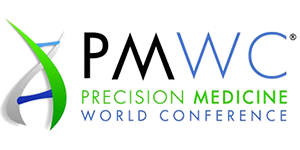
14 Sep Q&A with Chris Cournoyer, QIAGEN

Chris Cournoyer currently is a strategic advisor to QIAGEN following the acquisition of N-of-One in 2019. Previously, Chris served as the Chairperson and Chief Executive Officer of N-of-One, a leading molecular decision support company in oncology, from 2012- 2019. She currently sits on the Board of Directors for CareDx ,Inc. a leading precision medicine company focused on high value solutions for transplant patients and caregivers. Read her full bio.
Interview with Chris Cournoyer, QIAGEN – Track 4 Chair
Q: What are some of the biggest challenges we need to overcome to drive the adoption of clinical genomics and realize the benefits of truly personalized medicine? What promises for improved outcomes for a patient can we expect in a more technologically advanced personalized health system?
A: One of the biggest challenges impacting the adoption of personalized medicine in oncology includes having tools at the point of care to support patient-specific decision making on both the diagnostic side and the treatment strategy. Prior to the introduction of the first targeted therapy, oncology therapy was cancer type-specific and focused predominantly on surgery, radiation, and chemotherapy. The therapy decisions were, in many ways, less complex than they are today, now that physicians must contend with hundreds of targeted therapies that can address thousands of different mutations. The advent of personalized medicine and patient-specific therapies make it extremely challenging for the practicing physician in most institutions to – in a timely manner – determine the most effective treatment path for a specific patient with a specific disease manifestation. FDA approved drugs and NCCN guidelines are all helpful and necessary, but the treatments don’t cover all patients, particularly those with rare mutations and resistance mutations. An N-of-One analysis of over 20,000 NGS test results for non-small cell lung cancer (NSCLC) patients indicated that only 25% of the patients had a mutation that could be targeted by an FDA approved drug, while 61% of the cases would more likely benefit from participation in a clinical trial. In other disease areas, the percent of patients that can be treated by an FDA drug is considerably smaller. Given such a large population of patients with rare mutations and the myriad of variants and cancer sub types, sophisticated tools are necessary for the physician to support patient specific analysis and decision making.
Providers aren’t the only ones who need these tools. Payers would benefit from these tools as well, as they are often asked to approve tests and drugs that are not covered in the guidelines. Payer reimbursement models need to cover the reimbursement for both the test and the drug, thus requiring evidence to support the value of the test and the evidence to support a therapy that goes beyond the standard of care, which most patients will require as their cancer progresses. Payers do not want to reimburse a test if the test won’t lead to what they believe is an “actionable” outcome. Many payers believe that an actionable outcome solely encompasses drugs that are FDA approved or included in the NCCN guidelines. These decision models, unfortunately, do not cover the majority of cancer patients. A further analysis of just the 5,700 NSCLC patients with an EGFR gene mutation indicated that only about 60% of the patient cases had mutations that were well known and listed in the NCCN guidelines. The remaining 40% of patient cases were divided between rare mutations that were actionable, in which a clinical trial (either of an investigational drug, or an approved drug being tested on rare mutations) may be the most effective and appropriate course of action, or VUS (Variant of Unknown Significance), where no evidence exists to suggest a drug would be effective. Without tools that support variant analysis and provide evidence for the predictive value of the variants, both the provider and payer are left with little easily available evidence to determine the most appropriate strategy for up to 40% of these patient cases.
Clinical trials are often a good treatment option, but identification of the most relevant trial for a patient is complex. The patient’s molecular profile, along with the clinical attributes, must be analyzed against eligibility criteria of relevant trials. This analysis needs to be timely and delivered to the point of care. Few solutions today combine both clinical and molecular attributes in the selection of trials, often leaving the oncologist with dozens of trials to comb through. Enhanced trial matching tools as part of a comprehensive oncology decision support solution may help reduce the barrier to improving overall trial enrollment rates in oncology. With over 500 drugs in the late stages of clinical evaluation, many drugs, according to research conducted by Optum Health, will simply fail to come to market because they cannot enroll sufficient numbers in the clinical trials. High failure rates are one of the factors driving the cost of these targeted and immunotherapies.
Finally, as we see wider adoption of molecular testing, we are met with the challenge of how to incorporate both germline and somatic findings. Not only does this challenge involve complexities in the interpretation of the biomarkers but highlights the need for tools required to analyze both somatic and germline simultaneously. But the bigger challenge, I believe, is for the labs and providers to offer genetic counseling at scale for a much broader population. There is a shortage of genetic counselors who have the knowledge of the growing number of germline biomarkers, and they need tools and content to support the growing number of patients being tested who will require insight and counseling.
The goal of improving patient outcomes will be achieved as we create a learning system that is built on big data that can be easily analyzed and then digested at the point of care, a system that is constantly growing and incorporating new information and insights.
Q: Genomics, Digital Health, Big Data, and Artificial Intelligence are some of the newest technologies/fields that are reshaping medicine and healthcare. How can these technologies impact personalized medicine and overall healthcare?
A: Technology is impacting every aspect of healthcare, from more advanced diagnostics tests to enhanced personalized treatment strategies and wearable devices that allow more active patient monitoring throughout the care cycle.
Solutions that automate the provider’s workflow in all settings and provide for seamless integration of electronic medical data across the health system can greatly improve overall healthcare. In personalized medicine for oncology, digitized patient records that can be shared across providers needs to become more widespread. This would foster more efficient collaboration and coordinated care across the health system allowing patients to receive diagnostic and treatment strategies at a centralized precision medicine program facility while being provided their on-going care, such as infusions or radiation, closer to home, all at a potentially lower cost. Technology that enables molecular diagnostic testing that can be tracked longitudinally, along with clinical decision support systems that can alert physicians to changes in test results that may require changes to treatment can improve overall outcomes and efficiency. Examples in oncology include liquid biopsies that can detect early emergence of medication resistance markers to stay ahead of progression, or for the detection of transplant rejection markers in transplant patients to prompt physicians to take action before symptoms occur. With digitized patient records, aggregated longitudinal monitoring of granular molecular patient cohorts can become a standard that is very cumbersome to reach today. Technology that aggregates all diagnostic tests, prior treatments and provides a visual display that allows for virtual collaboration would additionally enhance the productivity of tumor boards. Digitized electronic medical records will enable larger data sets to be aggregated and, combined with artificial intelligence. Such records can provide greater insight into the treatment responses and create a dynamic learning system which would not only improve patient outcomes but also the efficiency of the drug development process by creating a more timely and valuable feedback loop to pharma.
Q: What is still lacking in order for us to be able to take advantage of the full potential of these technologies and what is it that we can realistically expect from these technologies and in what timeframe?
A: “We are in the early days of applying technology to healthcare in comparison to other industries.”
We are in the early days of applying technology to healthcare in comparison to other industries. Automating the clinical workflow by implementing electronic health care records was only legislated ten years ago by the HiTECH Act. Creating a digitized patient record is a basic foundation that enables technology to transform the way healthcare is delivered. In the rush to comply with meaningful use standards, the implementation of EHR systems has often resulted in digitized records that contain valuable clinical information but in an unstructured format, where critical data is essentially hidden in pathology reports, lab reports, and physicians’ text notes. Additionally, many of the large health systems who have grown through acquisition and mergers over the past ten years, and even those that may have retained the same EHR vendor, lack standardization across the various systems using EHR. For example, different implementations may use different naming conventions, vocabularies for drugs, procedures, etc., thus making it cumbersome and complex to consolidate patient data even within one health system and virtually impossible to exchange patient data across ambulatory settings and hospitals. Most EHR records cannot accommodate a patient’s molecular profile and seamlessly integrate it into the overall patent record. This is not surprising when you realize that the introduction of the first targeted therapy for NSCLC was just fifteen years ago at a time when the EHR vendors were focused on the basics of interoperability and complying with the meaningful use of standards. But as we sit here today, most of the EHR solutions still do not provide a comprehensive solution to support precision medicine programs.
Providers need the ability to easily integrate patient molecular and clinical profiles, including genomic test results and therapies, into one record with discrete clinical data that can be easily accessed. Niche solutions are attempting to address the current gaps in the EHR systems but are forced to store – particularly the genomic data – in separate data silos. In oncology, several applications have been built to begin to address the data integration needed to support the growing number of molecular tumor boards. However, most precision medicine programs today must manually assemble and review the data needed by the Tumor Board. Clinical decision support solutions that can integrate and analyze all the patient data to suggest an appropriate patient specific treatment paradigm are only in their early stages. If the therapy option involves searching for a clinical trial, the solutions typically fall short by either ignoring the molecular implications or addressing only a subset of the clinical trial eligibility requirements. If the optimal therapy for a patient involves a clinical trial, providers are often faced with limited resources to support the patient in determining if they meet the trial eligibility requirements and often the trials is not available in a reasonable geographic area for the patient. Technology that can alert trial administrators that an eligible patient exists to support a “just in time” trial is in the formative stages. Once EHR data is standardized across vendors, hospital systems, payers, etc., artificial intelligence will become an essential tool to facilitate the useful aggregation and distribution of this information to bring it to the point of patient care.
“As we sit here today, most of the EHR solutions still do not provide a comprehensive solution to support precision medicine programs.”
Although technology exists to create the ideal learning systems in the near term it requires greater resources in curating the data so that the patient data that has historically been collected can be aggregated and used by machine learning systems.
Q: How is and can RWE be used by providers and pharma in the drug development process? Do the data sets exist today?
A: Real world data sets are a critical component in creating a learning system that allows us to modify and improve treatment strategies based on real world evidence. Many precision medicine programs strive to learn how patients with similar characteristics have done with similar protocols, creating a concept of analyzing “patients like me”. In oncology, where the patient is an n-of-one, this becomes particularly challenging as the oncology patient must be defined in granular clinical and molecular terms. For example, grouping all EGFR patients together and studying their response would not be appropriate if only 50% of the patients had an approved, on-label mutation and 50% of the cohort had a mutation that was unknown or not sensitive to the drug being studied. Thus, the molecular granularity of the cohort, as well as such variables as prior therapies, extent of metastases and other valuable clinical attributes, is paramount to drawing the correct conclusions. In addition to the rigor required in defining cohorts, the ability to track these patients over time, and to acquire large enough data sets to draw significant conclusions is also a prerequisite. Given these current limitations, it is difficult to amass the large data sets required to enable artificial intelligence to support therapy selection in oncology. However, there are movements across providers to share data sets to allow for greater data points to support analysis. Again, the challenge is normalizing the data across health systems.
Oncology drug development is increasingly biomarker driven and RWE is particularly important in improving the overall efficiency of the drug development process. Efficient development of a drug-specific companion biomarker requires knowledge of the size of the population possessing the target of interest and potentially other frequently co-occurring biomarkers, to appropriately scale trial design. Given the early stage of molecular testing, the availability of and access to large data sets with thousands of variants and their molecular associations has been limited. In turn, drugs have been developed with a very narrow list of target variants, requiring patient cohorts that are difficult to recruit for enrollment in clinical trials. To continue with an example using a well known class of drugs, such as EGFR inhibitors, drug developers need to know with accuracy which EGFR variants are sensitizing or actionable to allow for the broadest eligibility criteria in order to enable more widespread recruitment for clinical trials, while excluding patients that are unlikely to respond to the drug. Determining the size of the patient population with these variants is also valuable when forecasting the time frame for clinical trial enrollment as well as targeting trial sites to any geographic concentrations that may exist for this population. Particularly rare biomarkers with smaller patient populations may need a “just in time” approach to clinical trial enrollment versus those for more frequently seen mutations. Data sets are becoming more available as testing increases and labs with access to this data are able to aggregate it and provide it in useful and standardized ways to pharma. Foundation Medicine has certainly led this effort by combining its lab developed data set with patient data from Flatiron, creating a data set that includes both the clinical and genomic data set as well as a longitudinal dimension required for true outcomes analysis. Other data sets are becoming available as providers begin to think about how to aggregate their patient data sets to support drug development efforts.
Q: Can you touch upon the importance and relevance of the Track 4 content/sessions for these challenges and the track you are chairing?
A: Track 4 has been designed to provide insight into the innovative approaches and progress that is being made to address the technology challenges and achieve the vision of a learning healthcare system. We have some interesting sessions from leaders who are developing tools to streamline the NGS workflow and make it more efficient and, at the same time, lower the overall cost of sequencing. Professionals will examine the current state of the field and the progress being made across a variety of precision medicine programs, and the sessions will include talks that explore the progress being made with tumor boards and how they are evolving as testing strategies and treatment options become more complex. In addition, we have some excellent sessions on the state of clinical decision support solutions in determining oncology treatments as well as presentations on some interesting approaches towards improving overall clinical trial design and enrollment. Finally, in Track 4, we look at what RWE is being generated, how it is currently used and what its potential future uses are.
Q: What are you expecting PMWC attendees will walk away with from the PMWC 2020 Silicon Valley conference? What are some of the call to actions that we as a community should focus on?
A: I think we can all agree that we need a focus across all major stakeholders, such as patients, healthcare providers, and payers on improving the enrollment rates in clinical trials. Clinical trials often represent the best therapeutic option for so many cancer patients and getting access to these trials will require that we all work together to reduce the numerous enrollment barriers. We need trials that are designed with eligibility criteria that can better represent the cancer population characteristics being studied; we need better solutions to identify the most relevant trials for the provider; and we need payers to be more open to encouraging trials as an option.
“We need trials that are designed with eligibility criteria that can better represent the cancer population characteristics being seen in the clinic and we need payers to be more open to encouraging clinical trials as an option.”






